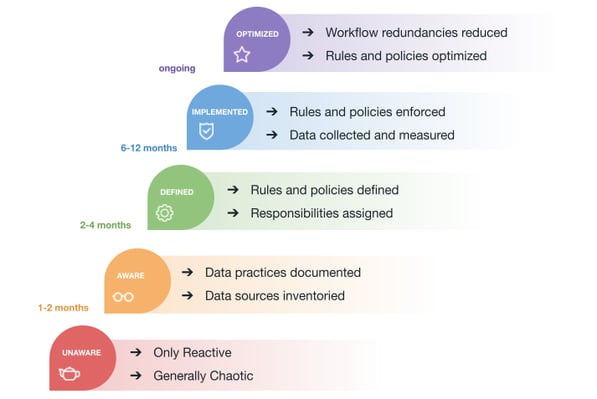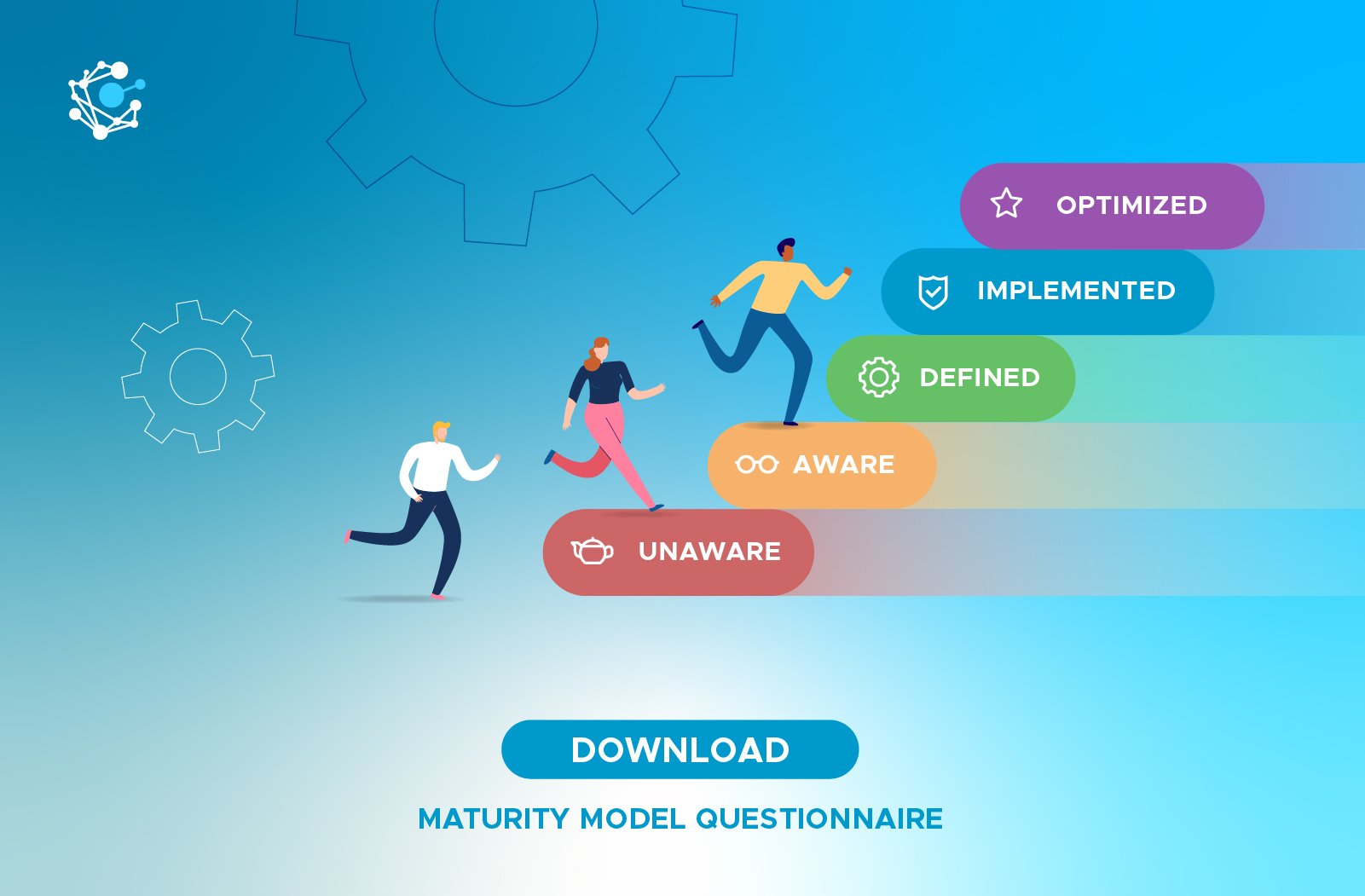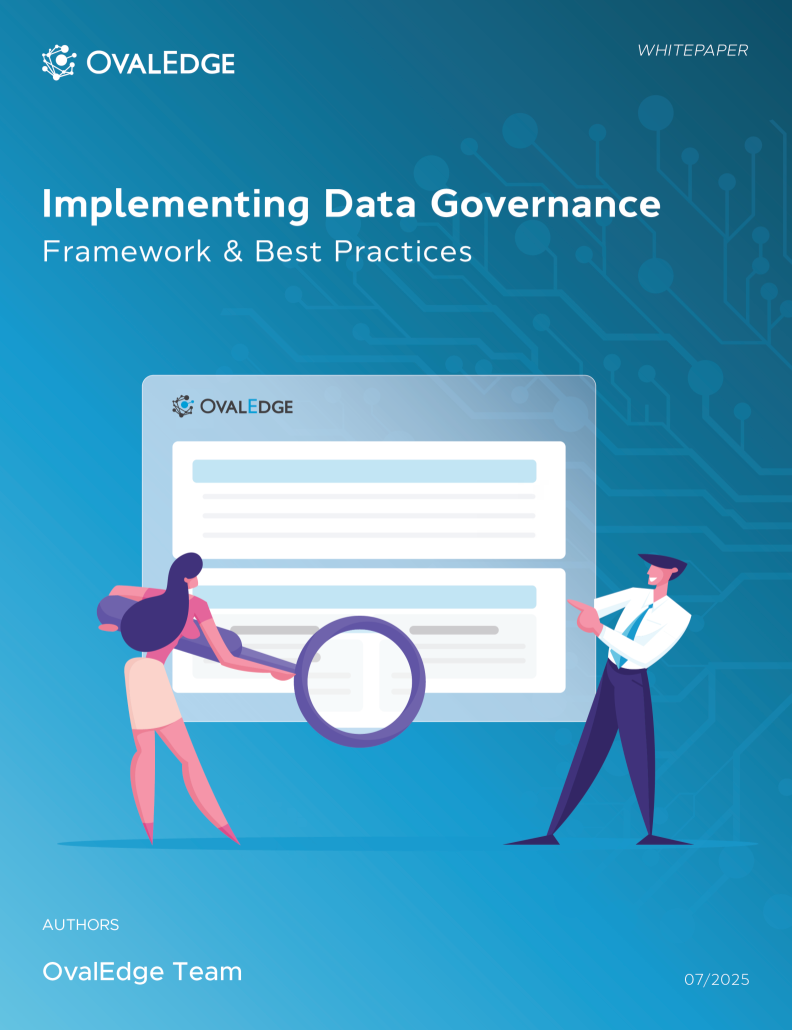Table of Contents
Data Governance Maturity Model: Measure & Improve Your Data Governance
Summary: A data governance maturity model is a tool and methodology used to measure your organization's data governance initiatives and communicate them simply to your entire organization.
.png?width=719&height=515&name=DG%20Maturity%20Model%20Graphic_V10%20(1).png)
Want to know your organization’s data maturity? Download our free Data Maturity Assessment.
The questionnaire includes an in-depth assessment of your organization’s data maturity with immediate results.
A data governance maturity assessment provides you with a way to understand the level of data maturity in your organization. Calculating data maturity is critical in understanding where you are on your data governance journey and where you need to be.
Introduction
In an organization where data governance protocols are absent, data quality cannot be guaranteed. When data is unstructured and changes made to it undocumented, its quality diminishes—fast. Not only is this a major headache for data teams, but it prevents business users from using company data to innovate.
Bad quality data and non-existent data management processes lead to inaccurate data sets. And when data is wrong, there can be catastrophic consequences, from detrimental business decisions to potential data breaches and costly compliance violations.
To combat these issues, organizations must deploy a data governance strategy, but for this strategy to be a success, there needs to be a high level of data maturity. The best way to achieve this is by adopting a data governance maturity model.
Data Governance Maturity and Its Models
To achieve a superior level of data governance maturity, organizations must adhere to a data governance maturity model. There are many examples of this model, but before we dive deeply into the most recognized ones, let’s explain the terms that define them.
What Exactly is Data Governance Maturity?
Data governance maturity refers to the stage an organization has reached in implementing and adopting data governance initiatives. An immature organization will have a great deal of unorganized data and will not be using this data to drive growth. Alternatively, a mature organization will be well aware of the importance of data as a key business asset and govern and manage it accordingly.
And, What is a Data Governance Maturity Model?
A data governance maturity model is a tool and methodology used to measure your organization's data governance initiatives and communicate them simply to your entire organization. In a mature organization, all the processes to manage, access, and innovate using data assets are in place. Less advanced organizations can use the maturity model to achieve this objective.
There are a handful of well-known data governance maturity models, including examples from IBM, Stanford, Gartner, and Oracle. These models provide a method by which a business can learn how to manage data effectively, provide user access, ensure that data is of high quality, and make it possible for everyone in an organization to benefit from these advances.
There's no one-size-fits-all model for data maturity, and even when you do select one, you’ll need to adapt it to suit your organization.
When a company achieves the highest level of data governance maturity, it will see palpable results. Company-wide, data will be used to innovate and collaborate and make better business decisions, while these same organizations will avoid the huge fines that arise when data protection regulations are not observed.
Which Data Governance Maturity Model Should You Use?
Although there are several data governance maturity models out there, the best known were developed by OvalEdge, IBM and Gartner. As mentioned earlier in this blog, a maturity model is a tool for measuring the level of your data governance capabilities. So, you must ensure that when you adopt a maturity model, you also have in place a data governance framework and roadmap that follows the same methodology.
When you set out to decide on a data governance maturity model you need to consider many factors. These include key business drivers, the budget required to implement the model, the existing data management and governance framework, and the industry you operate in.
Related: How Chief Data Officers overcome three key challenges they face
Progressive Data Governance Maturity Model
The objective of every data governance maturity model is the same, but neither Gartner nor IBM provide the detail required to overcome the challenges businesses will face. Our approach enables companies to track the progress of their data governance initiatives.

Level 1: Unaware
- Unaware of the importance of data
- No action taken
- Processes are reactive and generally chaotic
Level 2: Aware
- There is an awareness of the importance of data
- Existing data practices are understood and well documented
- An inventory of data sources is available
Level 3: Defined
- Data governance rules and policies are defined
- Data owners and data stewards are identified
- A governance committee is set up
- A data catalog is installed
Level 4: Implemented
- Data governance policies and implementing rules are enforced
- There is training conducted
- Data is collected and measured
- Alerts are set up to monitor data quality issues raised by users
Level 5: Optimized
- Rules and policies for better efficiency are optimized
- Redundancies are reduced with redesigned workflows
- Users tag data to increase discoverability
The OvalEdge data governance maturity model should be applied to three core areas of data governance: data quality, data access management, and data literacy. The aim is to independently apply this model to each of the three areas and tackle data governance progressively.
The best way to understand your company's level and then progress on the next is to ask data users questions with a formal questionnaire. This will enable you to understand where your organization is, what your staff knows, and what they don't.
IBM Data Governance Maturity Model
The IBM data governance maturity model is one the most widely recognized. Developed in 2007, the model is designed to help you determine your progress across 11 core data governance areas. These include data awareness and organizational structure, data policy, data stewardship, data quality management, data lifecycle management, IT security and privacy, data architecture, data classification, compliance, value creation, and auditing.
Level 1: Initial
- Limited to no data processes or governance
- Data management is ad-hoc and reactive
- There are no formal procedures for tracking data
- Deadlines are missed and project budgets are exceeded
To progress to level 2, data teams should audit how data is shared in their organization and create a plan that includes data owners and other stakeholders.
Level 2: Managed
- Users are aware of the business value of data
- Several data projects, such as mapping data infrastructure, are underway
- There is a small degree of automation
- Measures for regulating data have been agreed upon and are available
- Data teams are beginning to focus on metadata
To reach level 3, regulatory measures need further development and documentation. To initiate this, you need to begin creating models that map your key infrastructure and requirements.
Level 3: Defined
- Data policies are well-defined
- Some data stewards have been identified and appointed
- There is some data management technology in use
- A data integration plan is being worked on
- Users are sharing and understanding data management processes
- Master data management is commonplace
- Data quality risk assessment measures are in use
As you continue to specify and implement data policies and management processes, your organization will progress to level 4.
Level 4: Quantitatively managed
- Data policies are well-defined
- Enterprise-level data governance measures are in place
- Well-defined data quality goals are in place
- Data models are readily available
- Data governance principles drive all data projects
- Performance management is live and underway
To achieve the highest level of data maturity, you must concentrate on producing KPIs and other performance metrics. To achieve this, you must develop a clear, concise plan for executing data models.
Level 5: Optimizing
- Data management costs are reduced
- Automation is commonplace
- Clear and comprehensive data management principles are adopted company-wide
- Data governance is part of company culture
- It's standard practice to calculate and track ROI on data projects
A mature organization will be well-aware of the importance of data as a key business asset and governing and managing it accordingly.
Gartner Data Governance Maturity Model
Another widely recognized model is the Gartner data governance maturity model. Since 2008, the Gartner model has enabled enterprises to achieve five major goals:
- Company-wide data integration
- Content unification
- Master data domain integration
- Unhindered information channels
- Metadata management
Related: Data Governance & Metadata Management: Better Together
Level 0: Unaware
- There is no data governance, data ownership, or accountability in place
- There are no processes or architecture in place for information sharing
- There is no standardization or metadata management
- Most archiving and document sharing is completed via email
- There is no unification and data is fragmented
- Critical business decisions are made using inadequate information
Action item: Data teams and planners must educate key business leaders about the importance of data governance and focus on the potential implications of breaching compliance regulations.
Level 1: Aware
- The absence of data owners is apparent
- Business leaders acknowledge the lack of support for Enterprise Information Management (EIM)
- The value of data is becoming apparent
- There is a degree of awareness surrounding data quality issues
- There is awareness surrounding the need for standardized data policies and processes
- There is awareness of redundant reports and inefficient BI processes
- The risks of not having EIM in place are becoming clear
Action item: Data teams must develop an EIM strategy that fits with existing enterprise architecture and strategic business goals.
Level 2: Reactive
- Organizations understand the value of company data
- Data is beginning to be shared across departments, projects, and systems
- Data quality processes are reactive
- Policies have been created but adoption is low
- Data information and retention assessment processes are being developed
Action item: Key business leaders must promote the initial procedures and encourage adoption. At the same time, an overall value proposition must be made available.
Level 3: Proactive
- Data stewards and owners are identified and active
- Collaboration is recognized as a key enterprise process
- Roles and governance models are confirmed
- There is company-wide compliance with governance protocols
- Data governance is integral to every project's development and deployment
- Operational risks are reduced
Action item: Create and present an EIM strategy to business stakeholders and management and seek out EIM opportunities at the departmental level.
Level 4: Managed
- There is an enterprise-wide acceptance that data is critical
- Data policies have been developed, initiated and are well understood
- A data governance body has been created
- Data metrics are well-defined and accessible
Action item: IT management tasks must be inventoried to check they follow the EIM strategy. There should be a scorecard to rate data management processes.
Level 5: Effective
- Utilizing data and managing information is seen to provide a competitive advantage
- There are service level agreements (SLAs) in place
- Achieving productivity targets and risk reduction are two goals linked to EIM strategies
- The team responsible for EIM is well-established and active
- Core EIM goals have been achieved
Action item: Ensure measures are in place that guarantees EIM controls and quality standards continue regardless of changes at the leadership level.
How to Conduct a Data Governance Maturity Model Assessment
A data governance maturity model assessment is the foundation for understanding where your organization stands today and what it must do to reach higher maturity levels. It evaluates your organization’s policies, processes, people, and technology against a structured maturity model for data governance.
Here’s a step-by-step approach to conducting a comprehensive assessment:
1. Define the Scope and Objectives
Start by determining which areas of data governance you want to evaluate, such as data quality, data access management, data literacy, or metadata management. Clarifying the scope ensures the assessment aligns with your overall business goals.
2. Choose the Right Data Governance Maturity Model
Select a framework that best suits your organization’s size and industry. Common choices include the Gartner, IBM, or OvalEdge models. Each maturity model in data governance offers different levels and criteria to benchmark your progress.
3. Conduct a Structured Data Governance Maturity Assessment
Use a formal questionnaire or audit framework to measure current practices. This step often involves interviews with data owners, stewards, and business leaders. Assess aspects like data policies, compliance measures, and governance technology maturity.
4. Analyze the Results and Identify Gaps
Compare your current maturity level with the desired state. A data governance maturity model assessment highlights strengths, weaknesses, and areas where governance processes need optimization.
5. Develop an Improvement Roadmap
Use insights from the assessment to design a data governance roadmap. Prioritize actions that yield measurable business outcomes, such as improving data quality, reducing redundancy, or increasing accessibility.
6. Monitor and Reassess Regularly
Data governance is not a one-time initiative. Reassessing your data governance maturity every 6–12 months helps you track progress and ensure continuous improvement.
Conducting a maturity model data governance assessment enables your organization to establish clear goals, benchmark its progress, and move toward a culture of data-driven excellence.
Conclusion
Data is the most crucial driver of growth in modern businesses. Not only does it underpin critical business decisions, but it makes collaborative practices possible that aid company-wide innovation.
However, if you do not govern your data smartly, achieving these benefits is impossible. Wherever you are on your data journey, a data governance maturity model will enable you to calculate the level of data maturity your organization has reached. You can look back at where you have come from and determine the steps required to reach the highest level of data proficiency.
FAQs
- What is a data governance maturity model assessment?
A data governance maturity model assessment evaluates how effectively an organization manages and governs its data. It helps determine current maturity levels and identifies areas for improvement. - How often should organizations conduct a data governance maturity assessment?
It’s recommended to perform a maturity assessment annually or after any major change in data strategy, systems, or governance framework. - What are the key benefits of using a maturity model for data governance?
It provides a clear structure for improving data quality, compliance, access management, and data-driven decision-making. - How do you measure data governance maturity?
Measurement involves scoring your organization’s data governance practices against defined criteria across levels ,from “Unaware” to “Optimized.”
5. Which data governance maturity model is best?
The best model depends on your organization’s goals and complexity. Gartner and IBM models are widely used, but the OvalEdge progressive model offers detailed, actionable guidance.
Book a call with us to find out:
|
OvalEdge recognized as a leader in data governance solutions
.png?width=1081&height=173&name=Forrester%201%20(1).png)
“Reference customers have repeatedly mentioned the great customer service they receive along with the support for their custom requirements, facilitating time to value. OvalEdge fits well with organizations prioritizing business user empowerment within their data governance strategy.”
.png?width=1081&height=241&name=KC%20-%20Logo%201%20(1).png)
“Reference customers have repeatedly mentioned the great customer service they receive along with the support for their custom requirements, facilitating time to value. OvalEdge fits well with organizations prioritizing business user empowerment within their data governance strategy.”
Gartner, Magic Quadrant for Data and Analytics Governance Platforms, January 2025
Gartner does not endorse any vendor, product or service depicted in its research publications, and does not advise technology users to select only those vendors with the highest ratings or other designation. Gartner research publications consist of the opinions of Gartner’s research organization and should not be construed as statements of fact. Gartner disclaims all warranties, expressed or implied, with respect to this research, including any warranties of merchantability or fitness for a particular purpose.
GARTNER and MAGIC QUADRANT are registered trademarks of Gartner, Inc. and/or its affiliates in the U.S. and internationally and are used herein with permission. All rights reserved.



.webp)


